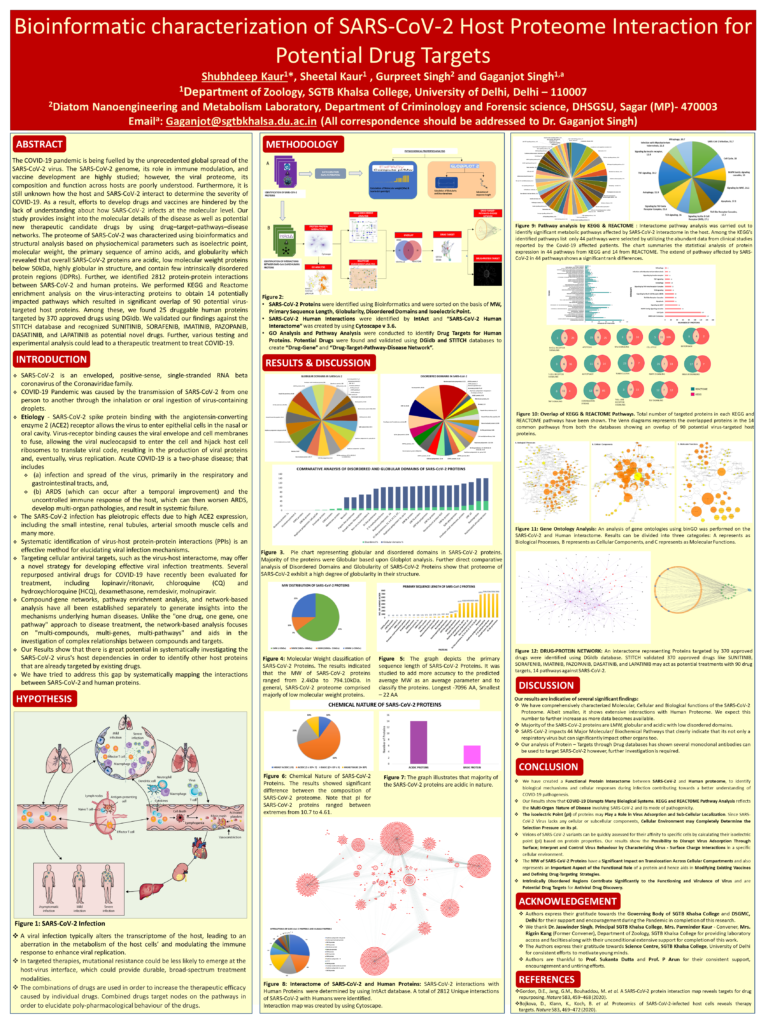Shubhdeep Kaur
Conference 2023 Presentation
Project title
Bioinformatic characterization of SARS-CoV-2 Host Proteome Interaction for Potential Drug Targets.
Authors and Affiliations
Shubhdeep Kaur1*, Sheetal Kaur1 , Gurpreet Singh2 and Gaganjot Singh1
1. Department of Zoology, SGTB Khalsa College, University of Delhi, Delhi – 110007
2. Diatom Nanoengineering and Metabolism Laboratory, Department of Criminology and Forensic science, DHSGSU, Sagar (MP)- 470003
Abstract
Background
The COVID-19 pandemic, which is caused by SARS-CoV-2, is the third zoonotic
introduction of a highly pathogenic coronavirus into the human population and has
caused unprecedented global societal and economic disruption. Systematic identification of virus-host protein-protein interactions (PPIs) is an effective method for elucidating viral infection mechanisms. Unlike the “one drug, one gene, one pathway” approach to disease treatment, the network-based analysis focuses on “multi-compounds, multi-genes, multi-pathways” and aids in the investigation of complex relationships between compounds and targets. We have tried to address this gap by systematically mapping the interactions between SARS-CoV-2 and human proteins.
Methods
SARS-CoV-2 proteins were extracted from protein databases. Proteins were analyzed based on various physicochemical properties like globularity, isoelectric point, molecular weight and the primary sequence length of amino acids. To further comprehend and identify the host cell pathways that are modulated by the virus, a network analysis of protein-protein interactions (PPI) between viral and host proteins was conducted. KEGG and REACTOME databases were used to carry out pathway enrichment analysis. The overlapping proteins between both databases resulted in the categorization of highly significant entities. Drug-gene and drug–target–pathways–disease interaction networks of the approved drugs for the overlapped proteins were predicted using the DGIdb2.0 and STITCH database.
Results
SARS-CoV-2 proteins are acidic, low molecular weight proteins below 50kDa, highly globular in structure, and contain few intrinsically disordered protein regions (IDPRs). The interaction map shows 2812 protein-protein interactions between 15 SARS-CoV-2 proteins. Based on pathway enrichment analysis, the SARS-CoV-2 proteome impacted 14 pathways and resulted in significant overlap of 90 potential virus-targeted host proteins. In these, we identified 25 human proteins that were targeted by 370 approved drugs. The validation of our findings led to the identification of SUNITINIB, SORAFENIB, IMATINIB, PAZOPANIB, DASATINIB, and LAPATINIB as potential novel drugs.
Conclusions
We have created a Functional Protein Interactome between SARS-CoV-2 and Human proteome, to identify biological mechanisms and cellular responses during infection contributing towards a better understanding of COVID-19 pathogenesis. Our Results show that COVID-19 Disrupts many biological systems and reflects the Multi-Organ Nature of the Disease. Our analysis of Protein–Targets through Drug databases has shown several monoclonal antibodies can be used to target SARS-CoV-2. Further, various testing and experimental analysis could lead to a therapeutic treatment to treat COVID-19.

